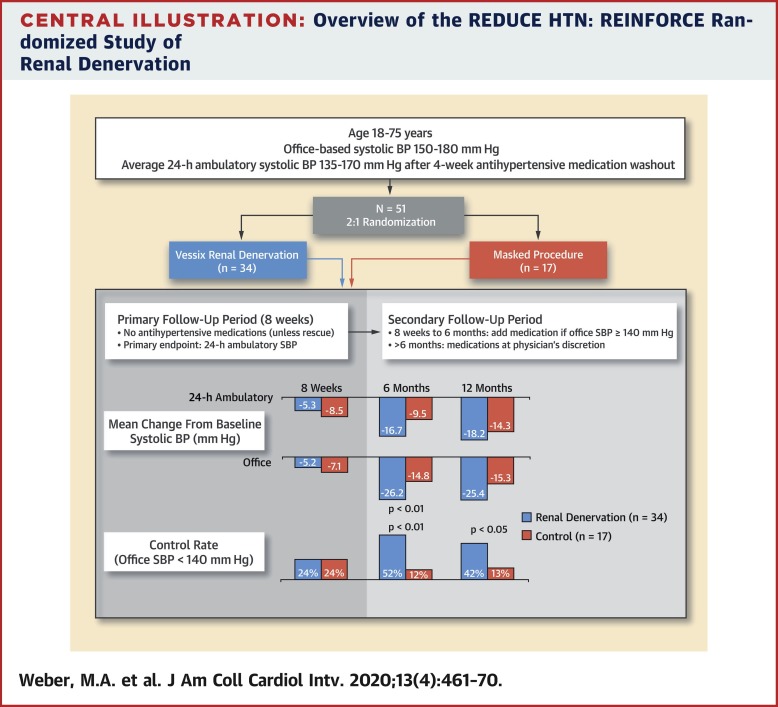当前位置:
X-MOL 学术
›
JACC Cardiovasc. Inte.
›
论文详情
Our official English website, www.x-mol.net, welcomes your feedback! (Note: you will need to create a separate account there.)
The REDUCE HTN: REINFORCE: Randomized, Sham-Controlled Trial of Bipolar Radiofrequency Renal Denervation for the Treatment of Hypertension.
JACC: Cardiovascular Interventions ( IF 11.3 ) Pub Date : 2020-02-24 , DOI: 10.1016/j.jcin.2019.10.061 Michael A Weber 1 , Ajay J Kirtane 2 , Matthew R Weir 3 , Jai Radhakrishnan 4 , Tony Das 5 , Martin Berk 5 , Farrell Mendelsohn 6 , Alain Bouchard 6 , German Larrain 7 , Michael Haase 7 , Juan Diaz-Cartelle 8 , Martin B Leon 2
JACC: Cardiovascular Interventions ( IF 11.3 ) Pub Date : 2020-02-24 , DOI: 10.1016/j.jcin.2019.10.061 Michael A Weber 1 , Ajay J Kirtane 2 , Matthew R Weir 3 , Jai Radhakrishnan 4 , Tony Das 5 , Martin Berk 5 , Farrell Mendelsohn 6 , Alain Bouchard 6 , German Larrain 7 , Michael Haase 7 , Juan Diaz-Cartelle 8 , Martin B Leon 2
Affiliation

|
OBJECTIVES
The aim of this study was to investigate bipolar radiofrequency renal denervation in patients with hypertension not receiving medications at baseline.
BACKGROUND
A blood pressure-reducing effect of renal denervation has been difficult to isolate in clinical investigations.
METHODS
REDUCE HTN: REINFORCE (Renal Denervation Using the Vessix Renal Denervation System for the Treatment of Hypertension) was a randomized, sham-controlled multicenter trial. Patients with office systolic blood pressure (SBP) of 150 to 180 mm Hg and average 24-h ambulatory SBP of 135 to 170 mm Hg after medication washout underwent bipolar radiofrequency renal denervation or a sham procedure. The planned outcome was 8-week change in 24-h ambulatory SBP. Enrollment was terminated for apparent futility before a sufficient sample for powered efficacy comparisons was enrolled. Safety assessments included all-cause death, renal failure, severe hypotension or syncope, hypertensive crisis, and renal artery stenosis.
RESULTS
Baseline 24-h blood pressure was 148.3 ± 10.9/85.7 ± 9.1 mm Hg for the denervation group (n = 34, mean age 58.5 ± 10.1 years, 47% women) and 149.1 ± 7.2/86.4 ± 9.8 mm Hg for the control group (n = 17, mean age 58.2 ± 9.8 years, 24% women). At 8 weeks, mean 24-h SBP reductions for the renal denervation and control groups were -5.3 mm Hg (95% confidence interval [CI]: -8.8 to -1.8 mm Hg) and -8.5 mm Hg (95% CI: -13.3 to -3.8 mm Hg), respectively (difference 3.3 mm Hg; 95% CI: -2.8 to 9.3 mm Hg; p = 0.30). Antihypertensive medications could then be added. By 6 months, decreases in SBP were greater for the denervation group, yielding between-group differences of -7.2 mm Hg (95% CI: -15.2 to 0.8 mm Hg; p = 0.08), -9.7 mm Hg (95% CI: -17.7 to -1.7 mm Hg; p = 0.02), and -11.4 mm Hg (95% CI: -19.2 to -3.7 mm Hg; p < 0.01) for 24-h, daytime ambulatory, and office measurements, respectively. Through 12 months, 1 patient (renal denervation group) had a hypertensive urgency requiring immediate management, and 1 experienced progression of renal artery stenosis.
CONCLUSIONS
Future studies of radiofrequency renal denervation must anticipate delayed treatment effects. (Renal Denervation Using the Vessix Renal Denervation System for the Treatment of Hypertension [REDUCE HTN: REINFORCE]; NCT02392351).
中文翻译:

REDUCE HTN:REINFORCE:双相射频肾脏去神经支配治疗高血压的随机对照试验。
目的本研究的目的是研究基线时未接受药物治疗的高血压患者的双极射频肾神经支配。背景技术肾去神经的降压作用在临床研究中难以分离。方法减少HTN:REINFORCE(使用Vessix肾脏去神经系统治疗高血压的肾脏去神经)是一项随机的,由假手术控制的多中心试验。药物冲洗后,办公室收缩压(SBP)为150至180 mm Hg,平均24小时门诊SBP为135至170 mm Hg的患者,接受双极射频肾去神经支配或假手术。计划的结果是24小时动态SBP的8周变更。由于明显的徒劳而终止了研究,因此没有足够的样本进行功效比较。安全评估包括全因死亡,肾衰竭,严重低血压或晕厥,高血压危象和肾动脉狭窄。结果失神经组的24小时基线血压为148.3±10.9 / 85.7±9.1 mm Hg(n = 34,平均年龄58.5±10.1岁,女性为47%),对照组为149.1±7.2 / 86.4±9.8 mm Hg组(n = 17,平均年龄58.2±9.8岁,女性占24%)。在第8周,肾脏去神经支配组和对照组的平均24小时SBP降低为-5.3 mm Hg(95%置信区间[CI]:-8.8至-1.8 mm Hg)和-8.5 mm Hg(95%CI:-分别为13.3至-3.8 mm Hg(差3.3 mm Hg; 95%CI:-2.8至9.3 mm Hg; p = 0.30)。然后可以添加降压药。六个月前 去神经组的SBP降低更大,组间差异为-7.2 mm Hg(95%CI:-15.2至0.8 mm Hg; p = 0.08),-9.7 mm Hg(95%CI:-17.7至-分别在24小时,日间门诊和办公室测量中分别测量1.7毫米汞柱; p = 0.02)和-11.4毫米汞柱(95%CI:-19.2至-3.7毫米汞柱; p <0.01)。在12个月内,有1名患者(肾神经支配组)患有高血压急症,需要立即治疗,并且1名患者经历了肾动脉狭窄的发展。结论射频肾神经去神经的未来研究必须预期延迟的治疗效果。(使用Vessix肾脏去神经系统进行神经支配治疗高血压[REDUCE HTN:REINFORCE]; NCT02392351)。p = 0.08),-9.7 mm Hg(95%CI:-17.7至-1.7 mm Hg; p = 0.02)和-11.4 mm Hg(95%CI:-19.2至-3.7 mm Hg; p <0.01)分别进行24小时,日间门诊和办公室测量。在12个月内,有1名患者(肾神经支配组)患有高血压急症,需要立即治疗,并且1名患者经历了肾动脉狭窄的发展。结论射频肾神经去神经的未来研究必须预期延迟的治疗效果。(使用Vessix肾脏去神经系统进行神经支配治疗高血压[REDUCE HTN:REINFORCE]; NCT02392351)。p = 0.08),-9.7 mm Hg(95%CI:-17.7至-1.7 mm Hg; p = 0.02)和-11.4 mm Hg(95%CI:-19.2至-3.7 mm Hg; p <0.01)分别进行24小时,日间门诊和办公室测量。在12个月内,有1名患者(肾神经支配组)患有高血压急症,需要立即治疗,并且1名患者经历了肾动脉狭窄的发展。结论射频肾神经去神经的未来研究必须预期延迟的治疗效果。(使用Vessix肾脏去神经系统进行神经支配治疗高血压[REDUCE HTN:REINFORCE]; NCT02392351)。1例患者(肾神经支配术组)患有高血压急症,需要立即处理,另有1例肾动脉狭窄进展。结论射频肾神经去神经的未来研究必须预期延迟的治疗效果。(使用Vessix肾脏去神经系统进行神经去神经支配治疗高血压[REDUCE HTN:REINFORCE]; NCT02392351)。1例患者(肾神经支配术组)患有高血压急症,需要立即处理,另有1例肾动脉狭窄进展。结论射频肾神经去神经的未来研究必须预期延迟的治疗效果。(使用Vessix肾脏去神经系统进行神经支配治疗高血压[REDUCE HTN:REINFORCE]; NCT02392351)。
更新日期:2020-02-20
中文翻译:

REDUCE HTN:REINFORCE:双相射频肾脏去神经支配治疗高血压的随机对照试验。
目的本研究的目的是研究基线时未接受药物治疗的高血压患者的双极射频肾神经支配。背景技术肾去神经的降压作用在临床研究中难以分离。方法减少HTN:REINFORCE(使用Vessix肾脏去神经系统治疗高血压的肾脏去神经)是一项随机的,由假手术控制的多中心试验。药物冲洗后,办公室收缩压(SBP)为150至180 mm Hg,平均24小时门诊SBP为135至170 mm Hg的患者,接受双极射频肾去神经支配或假手术。计划的结果是24小时动态SBP的8周变更。由于明显的徒劳而终止了研究,因此没有足够的样本进行功效比较。安全评估包括全因死亡,肾衰竭,严重低血压或晕厥,高血压危象和肾动脉狭窄。结果失神经组的24小时基线血压为148.3±10.9 / 85.7±9.1 mm Hg(n = 34,平均年龄58.5±10.1岁,女性为47%),对照组为149.1±7.2 / 86.4±9.8 mm Hg组(n = 17,平均年龄58.2±9.8岁,女性占24%)。在第8周,肾脏去神经支配组和对照组的平均24小时SBP降低为-5.3 mm Hg(95%置信区间[CI]:-8.8至-1.8 mm Hg)和-8.5 mm Hg(95%CI:-分别为13.3至-3.8 mm Hg(差3.3 mm Hg; 95%CI:-2.8至9.3 mm Hg; p = 0.30)。然后可以添加降压药。六个月前 去神经组的SBP降低更大,组间差异为-7.2 mm Hg(95%CI:-15.2至0.8 mm Hg; p = 0.08),-9.7 mm Hg(95%CI:-17.7至-分别在24小时,日间门诊和办公室测量中分别测量1.7毫米汞柱; p = 0.02)和-11.4毫米汞柱(95%CI:-19.2至-3.7毫米汞柱; p <0.01)。在12个月内,有1名患者(肾神经支配组)患有高血压急症,需要立即治疗,并且1名患者经历了肾动脉狭窄的发展。结论射频肾神经去神经的未来研究必须预期延迟的治疗效果。(使用Vessix肾脏去神经系统进行神经支配治疗高血压[REDUCE HTN:REINFORCE]; NCT02392351)。p = 0.08),-9.7 mm Hg(95%CI:-17.7至-1.7 mm Hg; p = 0.02)和-11.4 mm Hg(95%CI:-19.2至-3.7 mm Hg; p <0.01)分别进行24小时,日间门诊和办公室测量。在12个月内,有1名患者(肾神经支配组)患有高血压急症,需要立即治疗,并且1名患者经历了肾动脉狭窄的发展。结论射频肾神经去神经的未来研究必须预期延迟的治疗效果。(使用Vessix肾脏去神经系统进行神经支配治疗高血压[REDUCE HTN:REINFORCE]; NCT02392351)。p = 0.08),-9.7 mm Hg(95%CI:-17.7至-1.7 mm Hg; p = 0.02)和-11.4 mm Hg(95%CI:-19.2至-3.7 mm Hg; p <0.01)分别进行24小时,日间门诊和办公室测量。在12个月内,有1名患者(肾神经支配组)患有高血压急症,需要立即治疗,并且1名患者经历了肾动脉狭窄的发展。结论射频肾神经去神经的未来研究必须预期延迟的治疗效果。(使用Vessix肾脏去神经系统进行神经支配治疗高血压[REDUCE HTN:REINFORCE]; NCT02392351)。1例患者(肾神经支配术组)患有高血压急症,需要立即处理,另有1例肾动脉狭窄进展。结论射频肾神经去神经的未来研究必须预期延迟的治疗效果。(使用Vessix肾脏去神经系统进行神经去神经支配治疗高血压[REDUCE HTN:REINFORCE]; NCT02392351)。1例患者(肾神经支配术组)患有高血压急症,需要立即处理,另有1例肾动脉狭窄进展。结论射频肾神经去神经的未来研究必须预期延迟的治疗效果。(使用Vessix肾脏去神经系统进行神经支配治疗高血压[REDUCE HTN:REINFORCE]; NCT02392351)。


























 京公网安备 11010802027423号
京公网安备 11010802027423号